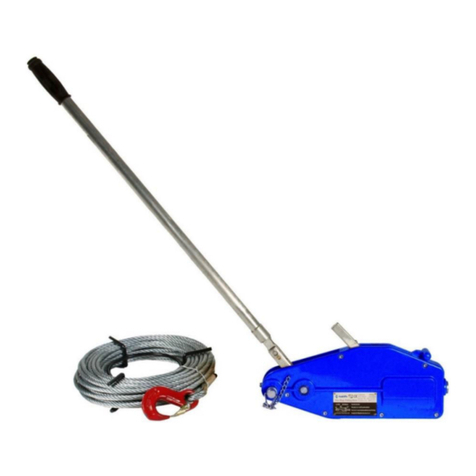
8
Należy przeprowadzać pomiary haków i łańcucha w celu
wykrycia ewentualnych zmian kształtu.
Inspekcje haka do mocowania ładunku (patrz rys. 4 i tabela 1)
Wymiar C otwarcia haka jest ważny. Zbyt duży wymiar oznacza, że
hak był narażony na przeciążenie lub przegrzanie. Nośność haka nie
jest więc dostateczna. Haki mogą być również narażone na długoterminowe
zużycie (wymiar K).
Haki należy złomować i wymieniać w następujących okolicznościach:
• Przekroczenie maksymalnej wartości C (zgodnie z tabelą 1).
• Przekroczenie minimalnej wartości B (zgodnie z tabelą 1).
• Na powierzchni haka widoczne są pęknięcia.
• Hak jest zdeformowany lub uszkodzony w inny sposób.
Uszkodzone haki należy wymienić przed ponownym użyciem wciągnika łańcuchowego!
Tabela 1 Hak do mocowania ładunku
Maks. obciążenie ton 0,25 0,5 1 2 3 5 10 20
Model KTHA250 KTHA500 KTHA1000 KTHA2000 KTHA3000 KTHA5000 KTHA10000 KTHA20000
Wymiar C (nominalny)
mm
24 25,5 30 38,5 41,5 47 55 84
Wymiar C (maks.) mm 26,4 28,0 33 42,3 45,5 51,7 60,5 92,4
Wymiar K (nominalny)
mm
15 19 25 33,5 39 44,5 62 93
Wymiar K (min.) mm 13,5 17,1 22,5 30,2 35,1 40,0 55,8 83,7
Inspekcje łańcucha do podnoszenia ładunku (patrz rys. 5 i tabela 2)
Należy sprawdzić łańcuch do podnoszenia ładunku na całej długości w celu wykrycia ogniw zdeformowanych lub uszkodzonych w inny sposób.
Przeprowadzić pomiary kontrolne podejrzanych ogniw. Należy przeprowadzić pomiary obszarów ulegających zużyciu (zazwyczaj co 300 mm) i
pomiary kontrolne wewnętrznej długości 5 ogniw (wysokość 5 x P zgodnie z tabelą 2).
Rys. 5 Sprawdzanie wymiarów łańcucha
Tabela 2 Łańcuch do podnoszenia ładunku
Maks. obciążenie (ton) 0,25 0,5 1 2 3 5 10 20
Model KTHA250 KTHA500 KTHA1000 KTHA2000 KTHA3000 KTHA5000 KTHA10000 KTHA20000
Średnica ogniwa nominalna mm 4,0 5,0 6,3 8,0 10,0 9,0 10,0 9,0
Średnica ogniwa min. mm 3,6 4,5 5,7 7,2 9,0 8,1 9,0 8,1
Wysokość (5 x P) nominalna mm 60,0 75,0 95,0 120,0 150,0 135,0 150,0 135,0
Wysokość (5 x P) maks. mm 61,8 77,2 98,0 123,5 154,5 139,0 154,5 139,0
Łańcuch do podnoszenia ładunku należy zezłomować i wymienić w następujących okolicznościach:
• pęknięcie ogniwa,
• deformacja lub inne uszkodzenie ogniwa,
• przekroczenie minimalnej średnicy ogniwa,
• przekroczenie maksymalnej wysokości ogniwa w dowolnym punkcie,
• uszkodzenie łańcucha na skutek przegrzania lub odprysków przy spawaniu.
Łańcuchy do podnoszenia ładunku nie powinny być naprawiane – konieczna jest wymiana łańcucha. Jeżeli konieczne jest przedłużenie łańcucha,
należy go wymienić na nowy, dłuższy łańcuch.
Rys. 3 Łańcuch nie powinien być. Rys. 4 Hak do mocowania ładunku.
Skręcony łańcuch!
Prawidłowo Nieprawidłowo































